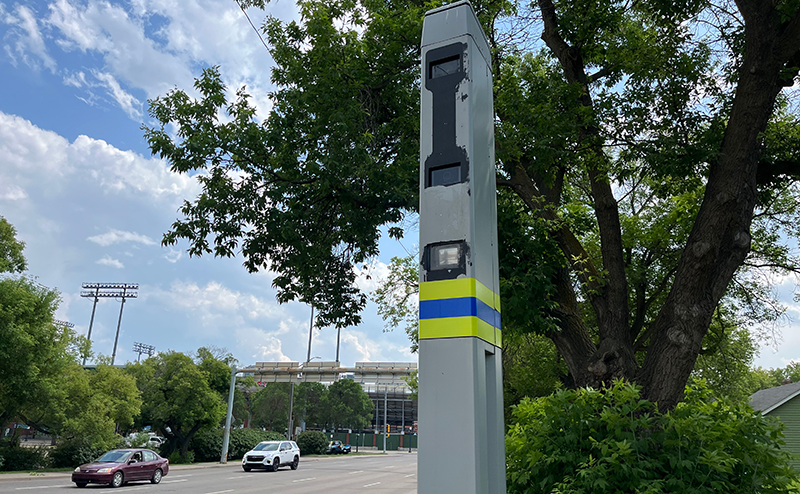
Automated enforcement is a proven and effective tool to make Edmonton’s streets safer for everyone and one of many important tools needed to achieve Vision Zero.
Encouraging safe driving is important to safe streets and livable communities because stopping at red lights and slowing down both give everyone more time to react to the unexpected, avoid collisions and lower the severity of collision-related injuries, especially for pedestrians.
The City is committed to transparent, accountable and evidence-based safe mobility programs to reach Vision Zero through the Safe Mobility Strategy.
Explore the Safe Streets Map to see all automated enforcement sites, intersection safety device locations and their site assessments. Site Assessments are provided in the format that is required for the City of Edmonton to be in compliance with Provincial Guidelines.
More information can be found online at the Alberta Government.
Tickets, otherwise known as a Notice of Offence:
- Are mailed out
- Have a photo of the vehicle and
- Contain details including the posted speed, violation speed and fine amount
If you receive a Notice of Offence for a red light or speeding violation, as the registered owner of the plate you will have options to respond.
The registered owner of the vehicle receives the ticket. This will not result in any demerit points assessed to your operator's licence.
Section 160(1) of the Traffic Safety Act states:
If a vehicle is involved in an offence referred to in Section 157 or a bylaw, the owner of that vehicle is guilty of an offence.
As of April 1, 2022, multiple traffic notices shall not be issued to the same vehicle within a five minute period in the same municipality. If more than one traffic ticket notice is issued within five minutes of each other in Edmonton, please email photoenforcement@edmonton.ca.
You can review full-sized, colour images of the alleged violation.
For up-to-date information, visit traffictickets.alberta.ca.
Once tickets have been issued, the Provincial Government is responsible for management of the process.
For information about how to contest a ticket, visit traffictickets.alberta.ca.
Intersection Safety Devices
Intersection safety devices are mounted above intersections to capture red light violations. Automated traffic-enforcement technology at intersections has proven to reduce the number and severity of crashes.
Signal-light violations rank in the top five collision causes for severity of injury and likelihood of fatalities. In 2023, these crashes caused a total of 27 fatalities and major injuries. Drivers are at fault in 80% of pedestrian crashes at signalized intersections.
Intersection safety devices monitor intersections and photograph vehicles that run through red lights.
Intersections are high-risk locations for collisions. Risky behaviour like running red lights has serious consequences, including collisions, injuries and death. These consequences are preventable.
Use this map of intersection safety devices to find out where they are located. On the street, each location is signed.
Red light cameras only photograph vehicles that enter a monitored intersection after the traffic light turns red. Our lane-specific technology detects moving vehicles and triggers the camera just before and after the vehicle enters the intersection to clearly show the violation occurred.
An amber or yellow light means that traffic facing the light is “warned” that a red light will soon follow. Alberta Transportation explains yellow, or amber, lights mean drivers must stop their vehicle before the stop line or crosswalk, unless a point has been reached at the intersection where stopping cannot be done safely. The yellow light does not mean to step on the gas to try and beat the light.
Braking distances increase in winter road conditions. This increases chances of running red lights and being involved in a crash associated with following too closely. When roads are wet, snowy, or icy, the distance required to come to a full stop increases even more. Drivers need to take this into consideration during winter months. We see an increase of red light running tickets when weather conditions affect road conditions, which is an indication that drivers need to slow down and leave extra distance between other vehicles and intersections to account for increased braking time.
In a winter city like Edmonton, road conditions can change quickly. The City’s priority is to ensure Edmontonians are able to move safely through the city in every season, no matter if they drive, walk, ride or use a mobility aid. City of Edmonton snow and ice crews work to help ensure safe travels for all. For more information, visit Winter Travel.
The picture is reviewed several times by specially trained reviewers who make sure the vehicle actually committed a violation. Once a violation has been verified, a violation ticket is issued and mailed to the vehicle’s registered owner.
Intersection Safety Devices undergo a comprehensive evaluation and testing procedure to ensure accuracy and reliability as required by the manufacturer and Province of Alberta Guideline.
Once a violation ticket has been issued, the Provincial Government is responsible for management of the process. For information about how to contest a ticket, visit traffictickets.alberta.ca.
Contact Us
311 Contact Centre
Phone 311 | Outside Edmonton and Video Relay Service (VRS): 780-442-5311 | TTY 711

